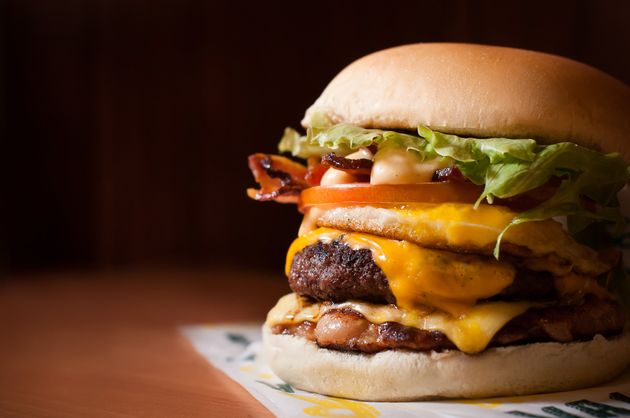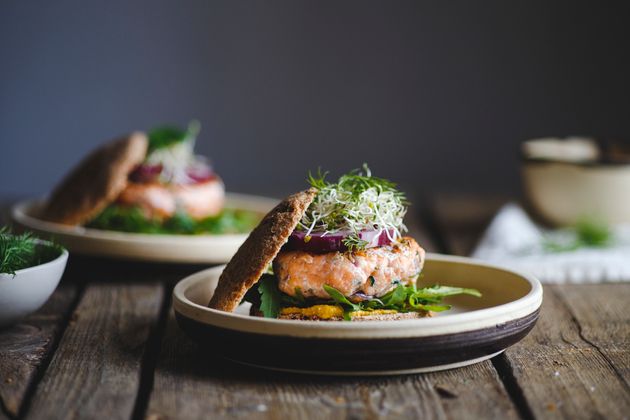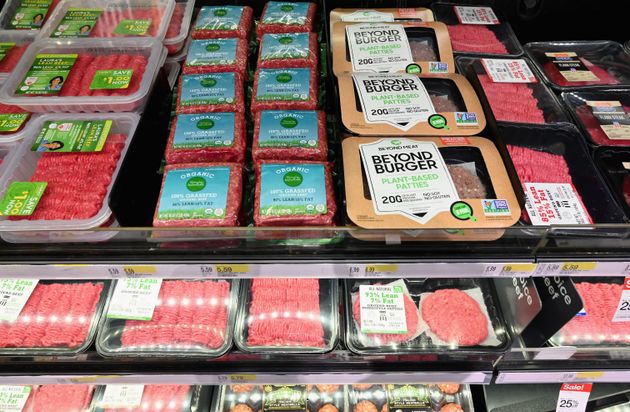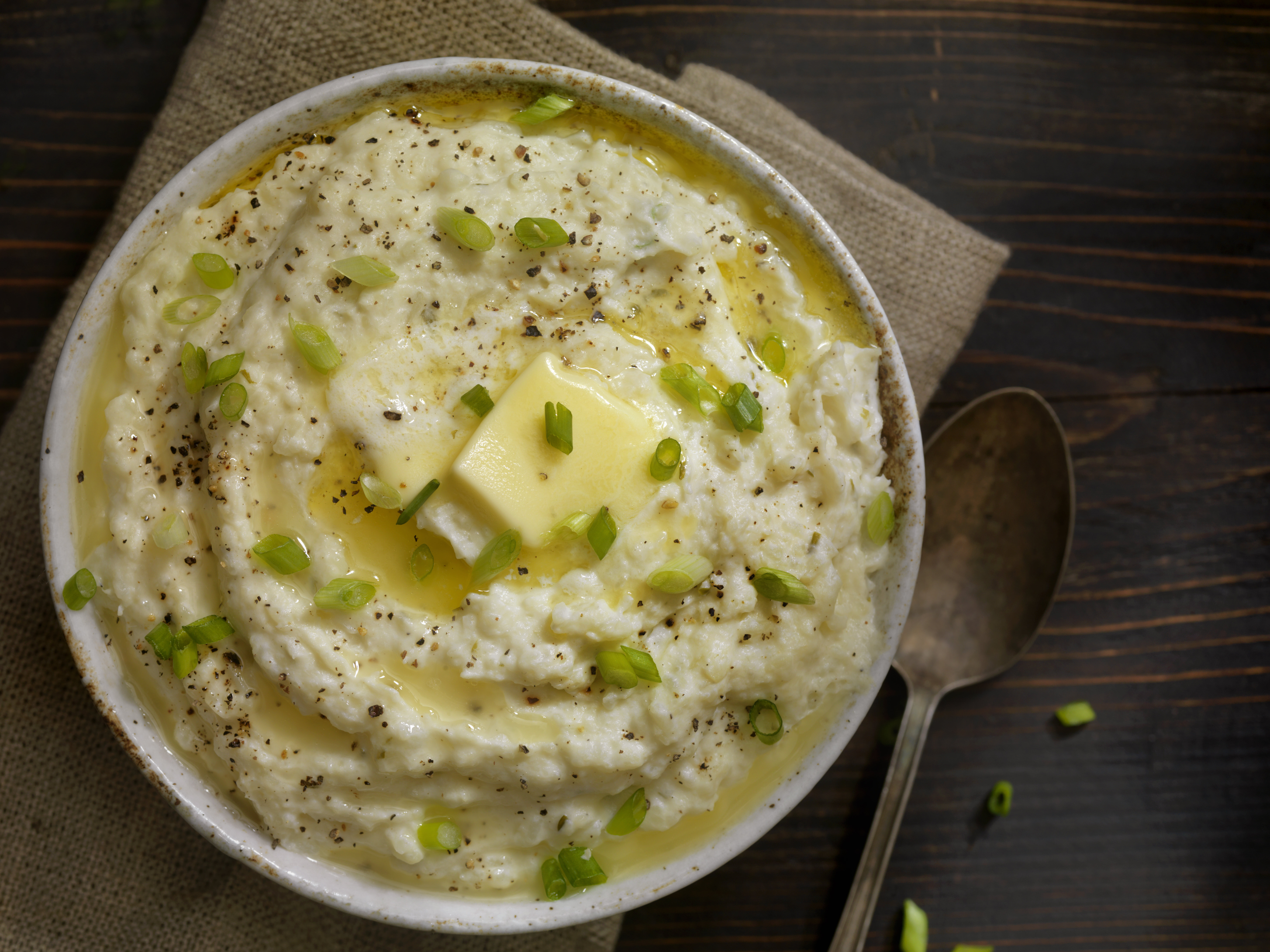
With summer cookouts on the horizon, burgers are one of the easiest things to slap on the BBQ. Making better-for-you choices during a burgerpalooza can be a challenge, so we asked nutritionists for guidance. Here’s their rundown on the burgers that deliver great taste and better nutrition, too.
#1 Salmon burgers
“This is my top choice for a burger,” registered dietician nutritionist Amy Gorin told HuffPost. “In addition to being a lean protein, salmon has heart-healthy EPA and DHA omega-3s.” RDN Amanda Frankeny had a similar opinion: “Most fish is health-promoting, but salmon stands out nutritionally.”
If you’ve struggled to find a pre-made salmon burger you like, registered dietician Barbara Ruhs suggests making them at home.
“The secret is to be gentle with your chopping and blending,” Ruhs told HuffPost. “I cut salmon fillets into bite-sized chunks, then gently pulse them in the food processor until they’re small enough to mix with other ingredients. My simple recipe is to add any mix of three fresh herbs, like dill, cilantro and chives. I add capers or relish with some mayo to keep the mixture from falling apart.”

#2 Grass-fed 90% lean beef burgers
“When I’m in the mood for a real-deal burger, I choose grass-fed beef for its superior flavour and nutrients, like omega-3 fatty acids and less saturated fat,”RDN Chelsey Amer said.
Still, this more expensive option is not for everyone’s budget, RDNVanessa Rissetto said. “But if you can afford it, or if you’re having burgers less often, it might be worth it,” she said.
“I don’t eat burgers that often, but once in a while, it’s great to enjoy one ― especially if it’s leaner and grass-fed beef,” Ruhs said.
She has pro tips for making a moister burger with this leaner meat. “Try adding a tablespoon or two of water right to the beef mixture to add moisture, and mix in some onions and herbs to help retain that moisture when you’re grilling. Finally, don’t add salt until the burger is cooked.”
#3 Turkey burgers
“Purely for flavour, I love a turkey burger when I’m in the mood,” Amer said.
Rissetto said this option is usually the leanest and easiest to digest. “It’s my go-to burger,” she said.
Frankeny had some tips to avoid what she called “that hockey-puck-on-a-bun quality” that can happen with an all breast-meat turkey burger.
“Enhance the flavour with garlic, onions and other aromatics,” Frankeny said. “Soften the patty by mixing in citrus juice, rolled oats, egg, breadcrumbs or mustard. Or top the cooked patty with a sweet-and-savoury glaze.”
#4 Veggie burgers
First of all, the nutritionists we spoke to were thumbs-down on the ever-popular Impossible or Beyond burgers as a vegetarian option. While they’re good for the planet, they’re highly processed and contain roughly the same amount of saturated fat as a beef burger.

But there are other types of veggie burgers out there. “Not all veggie burgers are created equally,” Gorin said. “I look for ones that are good or excellent sources of protein and fibre, which will help to keep you fuller for longer. And I also like when the sodium content is on the lower side.”
“Veggie burgers are an easy plant-based option, and they’re usually free from common allergens such as egg, nuts and soy,” RDNJerlyn Jones said. “Look for at least 10 grams of protein, under 440 mg of sodium and at least three grams of dietary fibre in your veggie burger.”
Frankeny likes veggie burgers that have “everyday ingredients,” like mushrooms, whole grains and walnuts. “They’ll add a meaty texture and hearty flavour,” she said.
She also suggested comparing nutrition facts labels. “For instance, depending on which brand you choose, sodium levels in a frozen veggie burger can range from 15 to 400 mg per patty.”
For packaged, frozen veggie burgers, Rissetto suggestedMorningstar Farms Grillers. “They taste pretty good, and I can name all the ingredients,” she said.
But Rissetto noted that many brands of veggie burgers contain fillers. She encourages people to make their own.
#5 Blended burger
(Meat blended with mushrooms and other veggies.)
Cochran is a fan of blended burgers. “They give you a great partnership of animal and plant foods,” she said. “You’ll increase the fibre of the burger while still getting the nutrients of beef, just in smaller amounts.”
“I love the idea of blending in mushrooms into your burger meat, which helps reduce the calorie and fat content,” Gorin said.
“As a plant-based dietitian, I appreciate an easy way to add more plants to meals.” Jones said, “I personally enjoy eating homemade turkey burgers blended with chopped mushrooms and spinach for a juicy and tender flavour.”
Ruhs said she’s made mushroom-blended burgers part of her cooking routine. “I love the umami that mushrooms add, and they make the burgers juicier, too. By adding mushrooms, you’re also saving money, since you can extend the beef by mixing it up at a ratio of 3:1 beef to mushroom.”
Runner up: Portobello mushroom burgers
Even though it didn’t make it into the top five of the nutritionist rankings, “I love a good portobello burger,” Gorin said. “However, on its own the mushroom doesn’t offer a lot of protein, so you can combine with sources of protein, such as a slice of cheese.”
Frankeny said: “I love how this vegetable stands up to grilling. Punch up the protein with a spoonful of garlicky hummus or a yogurt-based dressing on one side of the bun. More protein-packed accompaniments might be a nutty coleslaw or marinated three-bean, lentil or quinoa salad.”
Parting tips from the experts
Jones offered this safety guidance: “Undercooked animal protein has been associated with foodborne pathogens such as salmonella and E. coli bacteria, so make sure your animal protein burgers are safe to eat by cooking to 165 degrees Fahrenheit. Use a thermometer to check if the proper temperature has been reached.”
Ruhs said it’s a good idea to consider what’s on the rest of your plate, too.
“French fries or onion rings to accompany your burger once in a while is no big deal, but the name of the game is balance day-to-day,” Ruhs said. Once that great burger is cooked, she suggested loading it up with veggie toppings.
“My favourites are grilled mushrooms and onions, lettuce, spicy arugula, jarred roasted red peppers, pickled jalapeños, banana peppers, sweet pickle chips, crunchy dill pickles, avocados or fresh guacamole,” she said.
As another reason to pair burgers and veggies, Ruhs citeda studyfrom theUniversity of California, Los Angeles supported by theHass Avocado Board that showed adding half an avocado to a beef burger can help lower the inflammatory response caused by eating red meat.


